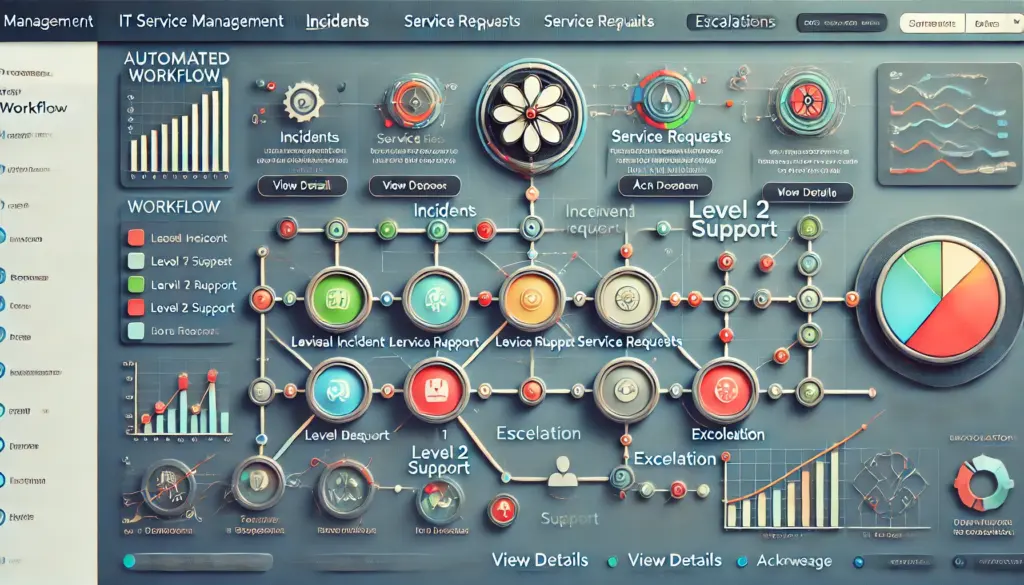Business Continuity Planning for Incident Managers
🔍 Introduction
In today’s fast-paced digital world, businesses rely on always-on services. But what happens when a critical system fails, a cyberattack occurs, or a natural disaster strikes?
💡 This is where Business Continuity Planning (BCP) comes in.
For Incident Managers, BCP ensures that organizations can quickly recover from disruptions with minimal impact on operations, customers, and reputation.
📌 In this guide, you’ll learn:
✔️ What business continuity planning is and why it matters
✔️ Key components of an effective BCP
✔️ The role of an Incident Manager in BCP
✔️ Best practices for ensuring business resilience

⚡ What is Business Continuity Planning (BCP)?
Business Continuity Planning (BCP) is the process of creating systems, processes, and protocols to ensure an organization can continue operating during and after a disruption.
It includes risk assessments, recovery strategies, and communication plans to minimize downtime.
🔥 Why is BCP Critical for Businesses?
🔹 Minimizes downtime and ensures service availability
🔹 Reduces financial losses caused by disruptions
🔹 Enhances customer trust by ensuring business stability
🔹 Improves compliance with regulatory requirements
📌 Example: A banking system outage can halt transactions, frustrating customers. A strong BCP ensures backup systems are in place to restore services quickly.
📌 Pro Tip: BCP is not just for IT incidents! It covers natural disasters, cyber threats, power failures, and even pandemics.
🏆 Key Components of an Effective Business Continuity Plan
📍 1. Business Impact Analysis (BIA)
A Business Impact Analysis (BIA) helps organizations identify critical systems, assess potential risks, and determine the impact of disruptions.
✔️ Identify mission-critical services
✔️ Determine the acceptable downtime (RTO) and data loss tolerance (RPO)
✔️ Assess financial and operational impact of disruptions
📌 Example: An e-commerce platform might determine that 30 minutes of downtime during peak shopping hours could result in millions of dollars in lost revenue.
📌 Pro Tip: Use BI dashboards (Power BI, Tableau) to analyze potential risks and track key metrics.
🔄 2. Risk Assessment & Mitigation Strategies
A solid risk assessment helps Incident Managers identify vulnerabilities and create strategies to prevent or reduce disruptions.
✔️ Conduct cybersecurity risk assessments to identify vulnerabilities
✔️ Implement disaster recovery solutions (backup systems, failover mechanisms)
✔️ Establish alternative communication channels
📌 Example: A cloud service provider might deploy multi-region redundancy to ensure availability even if a data center fails.
📌 Pro Tip: Use risk matrices to prioritize risks based on likelihood and impact.
🔧 3. Incident Response & Recovery Strategies
Incident response is at the heart of business continuity planning. Incident Managers must ensure that organizations can detect, respond, and recover quickly.
✔️ Implement automated monitoring tools for early detection
✔️ Define clear escalation processes for different incident types
✔️ Conduct regular disaster recovery drills
📌 Example: A ransomware attack could lock critical systems. A business continuity plan should include backup restoration strategies to recover encrypted data.
📌 Pro Tip: Use incident playbooks to standardize response actions for different scenarios.
📢 4. Crisis Communication & Stakeholder Management
During a crisis, clear and timely communication is crucial.
✔️ Define communication roles (e.g., Incident Commander, PR Lead, Technical Lead)
✔️ Use automated messaging tools (Slack, Microsoft Teams, PagerDuty)
✔️ Establish pre-approved response templates for different incidents
📌 Example: In case of a major outage, the Incident Manager should coordinate with IT teams, while the PR team manages external communication.
📌 Pro Tip: Set up a dedicated crisis response channel to ensure real-time updates.
📅 5. Regular Testing & Continuous Improvement
A business continuity plan is only effective if it’s tested regularly and continuously improved.
✔️ Conduct tabletop exercises to simulate real-world incidents
✔️ Review and update incident response playbooks
✔️ Gather post-incident feedback to improve response strategies
📌 Example: A tech company might run a simulated DDoS attack to test its ability to detect and mitigate threats.
📌 Pro Tip: Use AI-driven analytics tools to identify gaps in incident response performance.
🎯 The Role of an Incident Manager in Business Continuity Planning
Incident Managers play a crucial role in ensuring business resilience.
✅ Proactively identify risks and vulnerabilities
✅ Ensure real-time monitoring for quick incident detection
✅ Coordinate response efforts across teams
✅ Continuously optimize business continuity strategies
📌 Example: An Incident Manager at a cloud hosting company might implement automated failover systems to minimize service disruptions.
📌 Pro Tip: Stay updated with industry best practices and emerging cyber threats to adapt business continuity plans accordingly.
📊 Measuring the Success of Business Continuity Planning
Tracking key performance metrics helps assess the effectiveness of business continuity planning.
✅ Key Metrics to Track:
📌 Recovery Time Objective (RTO) → The maximum downtime a system can tolerate
📌 Recovery Point Objective (RPO) → The maximum data loss acceptable
📌 Incident Resolution Time → The time taken to resolve a disruption
📌 Customer Impact & Retention Rate → Measures how incidents affect business reputation
📌 Pro Tip: Use business continuity dashboards to track real-time KPIs.
📌 FAQs: Business Continuity Planning for Incident Managers
1. What is Business Continuity Planning (BCP)?
Business Continuity Planning (BCP) is a strategic process that ensures an organization can maintain operations and recover quickly in the event of disruptions such as IT failures, cyberattacks, natural disasters, or power outages. It includes risk assessment, incident response strategies, disaster recovery plans, and crisis communication protocols.
2. Why is Business Continuity Planning Important for Incident Managers?
Incident Managers play a key role in minimizing downtime and ensuring quick recovery during disruptions. BCP helps them:
✔️ Identify and assess risks that could impact business operations
✔️ Implement proactive monitoring and response strategies
✔️ Ensure clear communication with stakeholders during incidents
✔️ Develop robust disaster recovery plans
Without a solid BCP, organizations risk financial loss, reputational damage, and regulatory non-compliance.
3. What are the Key Components of an Effective Business Continuity Plan?
A strong BCP consists of:
✅ Business Impact Analysis (BIA) – Identifying critical services and acceptable downtime (RTO & RPO)
✅ Risk Assessment & Mitigation – Recognizing potential threats and implementing prevention measures
✅ Incident Response & Recovery Plans – Defining structured response processes to restore operations
✅ Crisis Communication Strategy – Ensuring clear, timely, and effective stakeholder communication
✅ Regular Testing & Optimization – Conducting disaster recovery drills to improve response effectiveness
4. How Does a Business Impact Analysis (BIA) Help in Business Continuity?
A Business Impact Analysis (BIA) helps Incident Managers:
📌 Identify mission-critical services and infrastructure
📌 Determine acceptable downtime (RTO) and data loss limits (RPO)
📌 Assess the financial and operational impact of different disruptions
📌 Develop prioritized recovery strategies
For example, an e-commerce platform may set a maximum downtime of 30 minutes, after which revenue loss and customer dissatisfaction increase significantly.
5. What are Recovery Time Objective (RTO) and Recovery Point Objective (RPO)?
✅ Recovery Time Objective (RTO) → The maximum allowable downtime before business operations are severely impacted.
✅ Recovery Point Objective (RPO) → The maximum acceptable data loss measured in time (e.g., last 5 minutes, 1 hour, 24 hours).
For example, a banking system might set an RTO of 15 minutes and an RPO of 0 minutes to avoid financial and data loss.
6. How Can Incident Managers Ensure Effective Crisis Communication?
Crisis communication ensures timely updates and clear instructions to minimize panic and confusion. Best practices include:
📌 Establishing dedicated communication channels (Slack, MS Teams, PagerDuty)
📌 Defining clear roles for crisis response teams
📌 Using automated alerts for faster incident reporting
📌 Training teams on emergency communication protocols
Example: If a DDoS attack affects a website, the IT team receives internal alerts, while customers receive status updates via email or social media.
7. How Often Should Business Continuity Plans Be Tested?
Regular testing is essential to identify gaps and improve incident response strategies. Best practices include:
✔️ Quarterly tabletop exercises to simulate different disaster scenarios
✔️ Annual disaster recovery drills to validate system resilience
✔️ Post-incident reviews to refine business continuity processes
Example: A cloud service provider might conduct a failover test to ensure systems automatically switch to backup servers during downtime.
8. How Can Automation Improve Business Continuity Planning?
Automation helps Incident Managers by:
🔹 Detecting anomalies and threats in real-time using AI-powered monitoring tools
🔹 Triggering automatic incident response actions (e.g., failover to backup systems)
🔹 Reducing manual intervention with automated ticketing and escalation
🔹 Generating real-time reports to track BCP effectiveness
Example: New Relic, Grafana, and PagerDuty automate performance monitoring and incident alerting for seamless business continuity.
9. What is the Difference Between Business Continuity Planning and Disaster Recovery?
| Aspect | Business Continuity Planning (BCP) | Disaster Recovery (DR) |
|---|---|---|
| Focus | Keeping the business operational during disruptions | Restoring IT systems and data after a disaster |
| Scope | Covers all business functions (people, processes, and technology) | Primarily focused on IT infrastructure |
| Example | Ensuring employees can work remotely during a natural disaster | Recovering lost data after a cyberattack |
10. What Are Some Common Challenges in Business Continuity Planning?
📌 Lack of regular testing and updates – Plans become outdated
📌 Poor communication – Unclear roles during incidents lead to confusion
📌 Underestimating cyber threats – Ransomware and DDoS attacks require specialized recovery strategies
📌 Insufficient backup systems – Failure to maintain redundant infrastructure leads to prolonged downtime
✅ Solution: Regular BCP audits, clear crisis communication strategies, and automated failover mechanisms.
11. How Can Organizations Measure the Success of Business Continuity Planning?
11. How Can Organizations Measure the Success of Business Continuity Planning?
To evaluate BCP effectiveness, track these key performance metrics (KPIs):
📌 Incident Resolution Time – How long does it take to recover from a disruption?
📌 Recovery Time Objective (RTO) vs. Actual Recovery Time – Was downtime minimized as expected?
📌 Customer Impact & Satisfaction – Did service disruptions affect customer trust?
📌 Compliance with Regulatory Requirements – Are BCP practices aligned with ISO 22301, NIST, or ITIL frameworks?
Example: If an organization’s target RTO is 15 minutes but it takes 2 hours to restore systems, the BCP needs optimization.
12. What Tools Can Help Incident Managers Improve Business Continuity Planning?
Some top tools for BCP and incident management include:
✔️ Monitoring & Alerts → New Relic, Grafana, Prometheus
✔️ Incident Response & Automation → PagerDuty, ServiceNow, Opsgenie
✔️ Disaster Recovery & Backups → AWS Backup, Veeam, Acronis
✔️ Communication & Collaboration → Slack, Microsoft Teams, Twilio
Example: AWS Backup ensures real-time snapshots and recovery options for cloud services.
🚀 Final Thoughts
A strong Business Continuity Plan (BCP) ensures organizations can withstand unexpected disruptions while maintaining operations and customer trust.
💡 Key Takeaways:
✔️ Conduct Business Impact Analysis (BIA) to assess critical risks
✔️ Implement real-time monitoring and automated incident response
✔️ Ensure effective crisis communication and stakeholder management
✔️ Regularly test, update, and improve business continuity strategies
📢 Next Steps:
🔹 Audit your current business continuity plan
🔹 Identify areas for automation and optimization
🔹 Implement regular disaster recovery simulations
📚 Learn More:
💬 How does your organization handle business continuity? Share your thoughts in the comments below!




